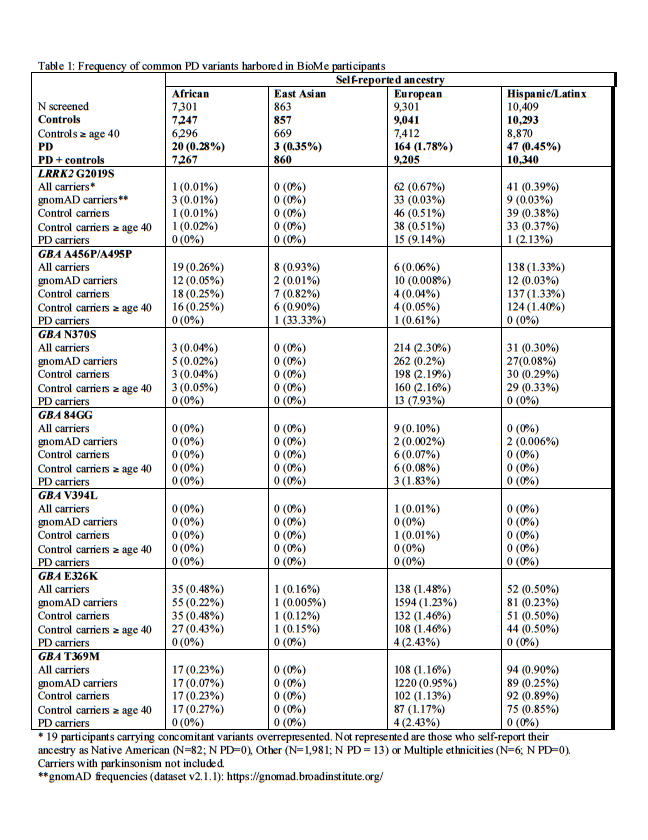Category: Parkinson's Disease: Genetics
Objective: To characterize the frequency of major LRRK2 and GBA variants in a multi-ethnic New York cohort with and without Parkinson disease (PD).
Background: There is a need to determine genetic contributions of PD in ethnically diverse populations, especially among Hispanic/Latinx and Black populations.
Method: WES data from BioMe, an ethnically/racially diverse cohort, with 35% Latinx, 24% African, and 32% European ancestry (Table 1), was evaluated for several established PD variants (LRRK2: G2019S; GBA: N370S, 84GG, A456P, V394L, E326K, T369M). Frequencies of PD variants by self-reported race/ethnicity and disease status (EMR chart review) were determined. Variant frequencies in non-PD (controls) were compared with gnomAD data.
Results: Among 26,969 participants, 247 had PD: 47 Latinx, 164 European, 20 African, 3 East Asian and 13 other ancestries (Table 1). LRRK2 G2019S variant was identified in 104 participants (62 European [59.6%], 41 Latinx [39.4%], 1 African, 0 East Asian ancestries), with higher frequency in Latinx and European ancestries compared to the population-based gnomAD database (p<0.001). GBA variants were identified in 867 participants (471 European [54.3%], 314 Latinx [36.2%], 73 African [8.4%], 9 East Asian [1.0%] ancestries). GBA N370S variant had higher frequencies in participants of Latinx and European ancestry vs. gnomAD (p<0.001). Despite the higher frequencies of these variants, variants among PD cases were predominantly seen in participants of European ancestry: LRRK2 G2019S (15/16 [93.75%]), GBA variants (25/26 [96.15%]).
Conclusion: In this large multi-ethnic cohort, LRRK2 G2019S and several GBA PD variants were present among individuals of non-European ancestries, especially of Latinx ancestry. However, the carrier frequencies were higher in controls compared to PD cases and population-based frequencies. As the discordant frequencies could not be solely attributed to younger age, this may suggest sampling bias in a clinical setting, lower genetic penetrance, or ancestry-specific genetic modifiers. Further studies are warranted to determine the contribution of LRRK2 and GBA mutations to PD risk in underrepresented populations. Study to catalogue additional variants in these populations, including those not attributed to PD, as well as ancestry analysis to determine cases attributable to Ashkenazi heritage, is underway.
To cite this abstract in AMA style:
A. Yoo, R. Ortega, V. Katsnelson, A. Debebe, A. Rendon, M. Picker, D. Raymond, S. Bressman, L. Ozelius, I. Peter, R. Saunders-Pullman. LRRK2 and GBA major variants in the New York Mount Sinai BioMe Biobank [abstract]. Mov Disord. 2022; 37 (suppl 2). https://www.mdsabstracts.org/abstract/lrrk2-and-gba-major-variants-in-the-new-york-mount-sinai-biome-biobank/. Accessed December 9, 2025.« Back to 2022 International Congress
MDS Abstracts - https://www.mdsabstracts.org/abstract/lrrk2-and-gba-major-variants-in-the-new-york-mount-sinai-biome-biobank/

